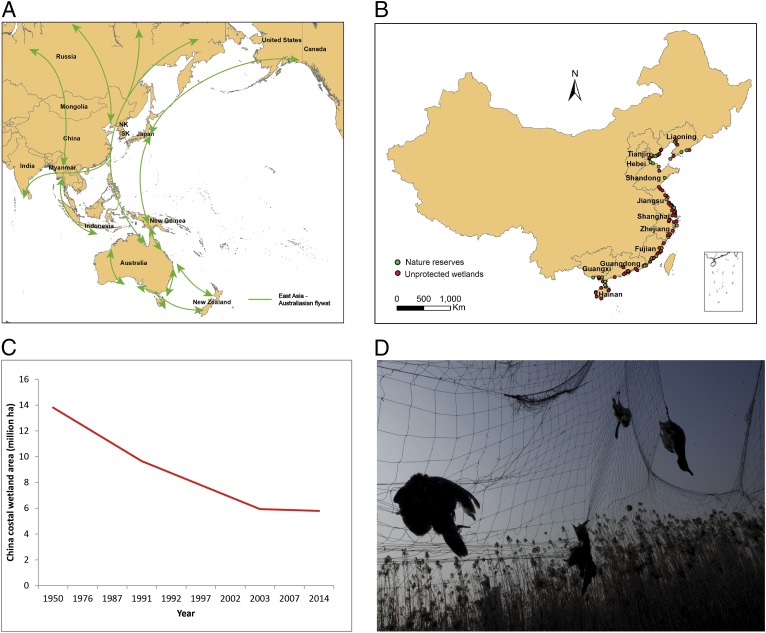Evaluating the significance of protected areas for biodiversity and ecosystem services is important for nature conservation. In a recent issue of PNAS, Xu et al. (1) present valuable information on provision of biodiversity and ecosystem services by China’s nature reserves. They conclude that reserves serve bird populations moderately well. However, the importance of coastal wetlands for migratory birds and the shortage of protected coastal sites are underplayed.
Migratory birds rely on networks of strategically located sites across their annual migration cycle. Loss or degradation of any one site can impact bird populations (2). In comparison to many studies, including the study of Xu et al. (1), which either omit parts of the annual migration or treat species’ distributions as static, Runge et al. (2) analyzed 520 bird species and found that protected areas covered only 9.6% of the range of China’s migratory birds, which is lower than the 16.4% suggested by Xu et al. (1) based on 127 species.
China’s coastal wetlands provide critical breeding, stopovers, and wintering sites for around 50 million migratory birds along the East Asia–Australian Flyway (3) (Fig. 1A). China has established 23 national coastal wetland reserves, with 15 designated as Ramsar sites (4) (Fig. 1B). However, the ecological character of many is threatened by land reclamation, infrastructure development, pollution, excessive fishing, alien species, and climate change. Of the 23 national coastal wetland reserves, 11 are in poor condition (4).
Fig. 1.
Limited and degraded coastal wetlands in China threaten migratory birds. (A) China’s coastal wetlands along the East Asia–Australasian Flyway. NK, North Korea; SK, South Korea. Global maps data from www.gadm.org/country. East Asian–Australasian Flyway data from ref. 3. (B) Nature reserves and unprotected major wetlands in China’s coastal zone. Nature reserves include national, provincial, and other nature reserves. Nature reserve and unprotected wetland data from ref. 7. (C) Decline in coastal wetland area in China. Data from ref. 4. (D) Illegal mist-netting in protected areas exacerbates the decline of migratory birds. This photograph was taken in Zhejiang Province. Reproduced with permission from www.cnsphoto.com.
Land reclamation and infrastructure development have major impacts. China lost 58% of its coastal wetlands (8.01 × 104 km2) between 1950 and 2014 (4) (Fig. 1C). Rapid development has transformed coastal wetlands into urban land or ports, for example, the Caofeidian port of Hebei, with an area of 310 km2, which is among the largest reclamation projects on Earth (5).
Along with shrinking wetland area and declining ecosystem quality, illegal mist-netting and poisoning accelerate the decline of migratory birds (Fig. 1D). Populations of more than 50% of bird species are falling, and at least 27 are endangered (6). The plight of the red-crowned crane (Grus japonensis) is clearly due to habitat loss. Worse, the population of the spoon-billed sandpiper (Calidris pygmaea) plummeted from 2,000–2,800 breeding pairs in the 1970s to about 220 in 2010. Many wetlands, for example, Rudong, Jiangsu, upon which these critical endangered species rely are excluded from the nature reserve network (4, 6, 7) (Fig. 1B).
Besides providing shelter, food, and breeding grounds for birds, wetlands support many ecosystem services, including coastal protection and flood control. Increasingly recognizing the importance of wetlands, China has drawn a “red line” to conserve at least 800 million mu (53.33 million ha) of wetland (8). However, wetland conservation must be integrated into local economic development plans. Wetland laws and effective enforcement are also needed to reverse the decline of wetlands and their associated wildlife (9).
Xu et al. (1) suggest four priority areas for new nature reserves, but coastal wetlands have particular problems. Urgent actions are needed for wetlands in the coastal zone. Although protected areas are usually designated at the national level, concerted global collaboration will be essential to safeguard internationally migratory species (10).
Acknowledgments
This work was supported by Fundamental Research Funds for the Central Universities (Grants XDJK2015B021 and SWU114108).
Footnotes
The authors declare no conflict of interest.
References
- 1.Xu W, et al. Strengthening protected areas for biodiversity and ecosystem services in China. Proc Natl Acad Sci USA. 2017;114:1601–1606. doi: 10.1073/pnas.1620503114. [DOI] [PMC free article] [PubMed] [Google Scholar]
- 2.Runge CA, et al. Protected areas and global conservation of migratory birds. Science. 2015;350:1255–1258. doi: 10.1126/science.aac9180. [DOI] [PubMed] [Google Scholar]
- 3.Larson C. Hostile shores. Science. 2015;350:150–152. doi: 10.1126/science.350.6257.150. [DOI] [PubMed] [Google Scholar]
- 4.Sun Z, et al. China’s coastal wetlands: Conservation history, implementation efforts, existing issues and strategies for future improvement. Environ Int. 2015;79:25–41. doi: 10.1016/j.envint.2015.02.017. [DOI] [PubMed] [Google Scholar]
- 5.Murray NJ, Clemens RS, Phinn SR, Possingham HP, Fuller RA. Tracking the rapid loss of tidal wetlands in the Yellow Sea. Front Ecol Environ. 2014;12:267–272. [Google Scholar]
- 6.Bai QQ, et al. Identification of coastal wetlands of international importance for waterbirds: A review of China Coastal Waterbird Surveys 2005-2013. Avian Res. 2015;6:12. [Google Scholar]
- 7.Xia S, et al. Identifying priority sites and gaps for the conservation of migratory waterbirds in China’s coastal wetlands. Biol Conserv. 2017;210:72–82. [Google Scholar]
- 8.Bai Y, et al. New ecological redline policy (ERP) to secure ecosystem services in China. Land Use Policy. 2016;55:348–351. [Google Scholar]
- 9.Yang H. China must continue the momentum of green law. Nature. 2014;509:535. doi: 10.1038/509535a. [DOI] [PubMed] [Google Scholar]
- 10.Kirby JS, et al. Key conservation issues for migratory land and waterbird species on the world’s major flyways. Bird Conserv Int. 2008;18:S49–S73. [Google Scholar]



